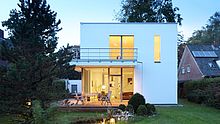
A building’s energy efficiency is a crucial factor in the construction of new builds or the refurbishment of older buildings. The German Energy Saving Ordinance (EnEV) and the Renewable Energies Heat Act (EEWärmeG) define many different energy standards that investors must adhere to in the construction of new builds.
Refurbishment offers significant potential
On the other hand, there are approximately 18 million existing residential buildings. Around three quarters of them were constructed before the First Thermal Insulation Ordinance was introduced in 1979. The majority of older buildings are unable to fulfil current energy standards. Efficiency potential is particularly high in these buildings, as the energy consumption in older buildings is frequently up to five times higher than in modern efficient houses.
This makes it particularly important to refurbish older buildings if the energy transition targets are to be reached. Above all, building owners must receive information and targeted funding in order to motivate them to carry out energy-efficient refurbishment. dena becomes involved at this point: among other things, it provides information on the benefits and opportunities of energy-efficient refurbishment.
The benefits of modern insulation, windows, heating and ventilation
Energy-efficiency measures achieve more than just reducing the energy costs. An efficiently heated house without draughty corners also provides a more pleasant living environment. The measures involved in energy-efficient refurbishment include the insulation of outside walls, the roof and the cellar, replacing windows (thermally insulated glass) and efficient heating systems for heating and hot water. It is also worth considering the use of renewable energies. Modern ventilation systems contribute to an improved room climate while filtering dust and pollen out of the air.
Competent advice on energy
Not all measures need to be carried out at once, of course. It is perfectly reasonable to complete refurbishments step by step. After all, there is no standard solution which can be applied to all buildings. Each house is unique and needs to be considered individually. Competent advice and good planning by an expert are important in order to guarantee the quality and cost effectiveness of the measures.
A detailed energy-efficiency analysis is conducted during qualified on-site advice on energy. A professional energy consultant reviews the requirements, recommends suitable measures that suit the specific building, and provides an initial overview of eligible funding programmes. Qualified energy consultants are listed in the Energy Efficiency Expert database. www.energie-effizienz-experten.de.
What the government does to support the energy transition in the building sector
The government subsidises energy-efficient building and refurbishment, for instance through KfW and the Federal Office for Economic Affairs and Export Control (BAFA).





